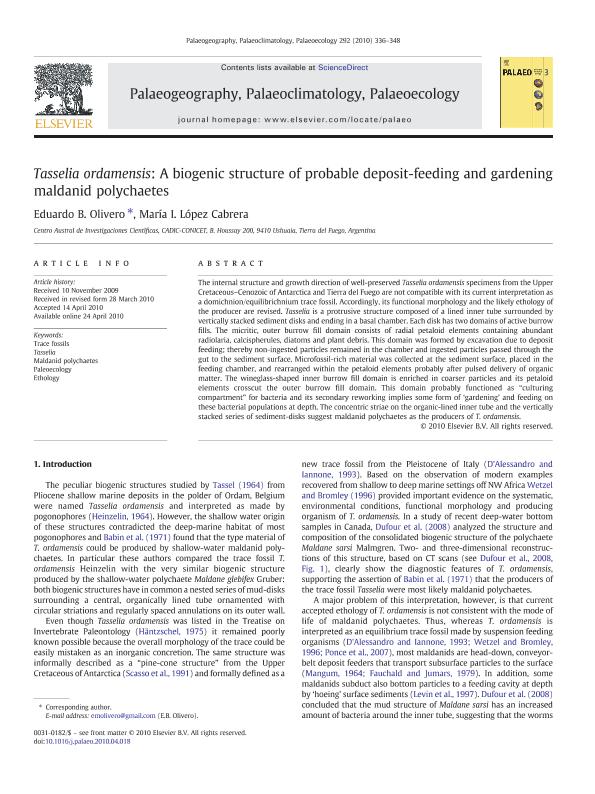Mostrar el registro sencillo del ítem
dc.contributor.author
Olivero, Eduardo Bernardo

dc.contributor.author
Lopez Cabrera O., Maria Isabel

dc.date.available
2017-02-07T20:28:24Z
dc.date.issued
2010-06
dc.identifier.citation
Olivero, Eduardo Bernardo; Lopez Cabrera O., Maria Isabel; Tasselia ordamensis: a biogenic structure of probable deposit-feeding and gardening maldanid polychaetes.; Elsevier Science; Palaeogeography, Palaeoclimatology, Palaeoecology; 292; 1-2; 6-2010; 336-348
dc.identifier.issn
0031-0182
dc.identifier.uri
http://hdl.handle.net/11336/12686
dc.description.abstract
The internal structure and growth direction of well-preserved Tasselia ordamensis specimens from the Upper Cretaceous–Cenozoic of Antarctica and Tierra del Fuego are not compatible with its current interpretation as a domichnion/equilibrichnium trace fossil. Accordingly, its functional morphology and the likely ethology of the producer are revised. Tasselia is a protrusive structure composed of a lined inner tube surrounded by vertically stacked sediment disks and ending in a basal chamber. Each disk has two domains of active burrow fills. The micritic, outer burrow fill domain consists of radial petaloid elements containing abundant radiolaria, calcispherules, diatoms and plant debris. This domain was formed by excavation due to deposit feeding; thereby non-ingested particles remained in the chamber and ingested particles passed through the gut to the sediment surface. Microfossil-rich material was collected at the sediment surface, placed in the feeding chamber, and rearranged within the petaloid elements probably after pulsed delivery of organic matter. The wineglass-shaped inner burrow fill domain is enriched in coarser particles and its petaloid elements crosscut the outer burrow fill domain. This domain probably functioned as “culturing compartment” for bacteria and its secondary reworking implies some form of ‘gardening’ and feeding on these bacterial populations at depth. The concentric striae on the organic-lined inner tube and the vertically stacked series of sediment-disks suggest maldanid polychaetes as the producers of T. ordamensis.
dc.format
application/pdf
dc.language.iso
eng
dc.publisher
Elsevier Science

dc.rights
info:eu-repo/semantics/openAccess
dc.rights.uri
https://creativecommons.org/licenses/by-nc-nd/2.5/ar/
dc.subject
Trace Fossils
dc.subject
Maldanid Polychaetes
dc.subject
Tasselia
dc.subject
Ethology
dc.subject
Paleoecology
dc.subject.classification
Paleontología

dc.subject.classification
Ciencias de la Tierra y relacionadas con el Medio Ambiente

dc.subject.classification
CIENCIAS NATURALES Y EXACTAS

dc.title
Tasselia ordamensis: a biogenic structure of probable deposit-feeding and gardening maldanid polychaetes.
dc.type
info:eu-repo/semantics/article
dc.type
info:ar-repo/semantics/artículo
dc.type
info:eu-repo/semantics/publishedVersion
dc.date.updated
2017-02-07T18:02:35Z
dc.journal.volume
292
dc.journal.number
1-2
dc.journal.pagination
336-348
dc.journal.pais
Países Bajos

dc.journal.ciudad
Ámsterdam
dc.description.fil
Fil: Olivero, Eduardo Bernardo. Consejo Nacional de Investigaciones Científicas y Técnicas. Centro Austral de Investigaciones Científicas; Argentina
dc.description.fil
Fil: Lopez Cabrera O., Maria Isabel. Consejo Nacional de Investigaciones Científicas y Técnicas. Centro Austral de Investigaciones Científicas; Argentina
dc.journal.title
Palaeogeography, Palaeoclimatology, Palaeoecology

dc.relation.alternativeid
info:eu-repo/semantics/altIdentifier/url/http://www.sciencedirect.com/science/article/pii/S0031018210002270
dc.relation.alternativeid
info:eu-repo/semantics/altIdentifier/doi/http://dx.doi.org/10.1016/j.palaeo.2010.04.018
Archivos asociados
